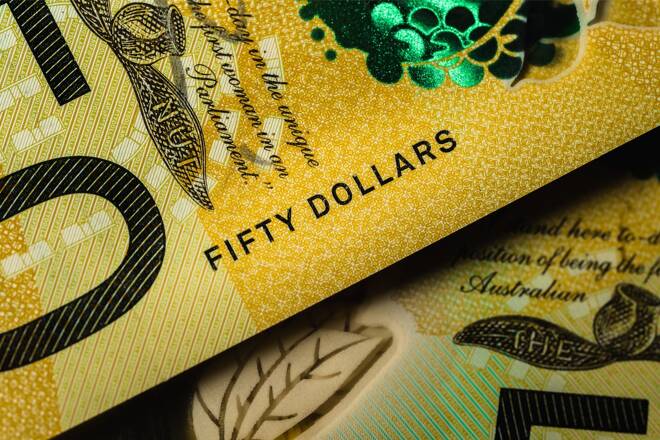Advertisement
Advertisement
AUD to USD Forecast: Is the Aussie Dollar at Risk from China’s Manufacturing PMI?
By:
The Aussie Dollar faces a turbulent day amidst economic jitters, with Chinese manufacturing PMIs and US inflation in sharp focus.
Highlights
- The AUD/USD slipped by 0.09% on Wednesday, partially reversing a 0.80% gain from Tuesday.
- Housing credit figures from Australia and Chinese private sector PMIs will impact economic outlook.
- US Core PCE Price Index, personal spending, and income numbers will influence Fed monetary policy.
Wednesday Overview
The AUD/USD slipped by 0.09% on Wednesday. Partially reversing a 0.80% gain from Tuesday, the Aussie Dollar ended the day at $0.64745. The Australian Dollar fell to a low of $0.64494 before striking a high of $0.65222.
China Manufacturing PMIs in Focus Amidst Economic Jitters
Hosing credit figures from Australia will draw interest this morning. The interest rate environment and an uncertain economic outlook could impact credit conditions.
A downward trend in housing credit would reflect a deteriorating macroeconomic environment. Banks tend to tighten credit terms, leading to a fall in housing credit. Weak demand impacts the housing sector and consumer confidence, leading to a fall in consumption. Economists forecast housing credit to increase by 0.3% in July versus 0.2% in June.
However, while the numbers will draw interest, Chinese private sector PMIs will have more impact. A deeper contraction across the manufacturing sector would reignite jitters about the Chinese economy. Economists forecast the NBS Manufacturing PMI to increase from 49.3 to 49.4 in August.
Investors should also consider the NBS Non-Manufacturing PMI. A fall to sub-50 would weigh. Economists forecast the Non-Manufacturing PMI to decline from 51.5 to 51.1.
US Inflation and Personal Spending in Focus
While investors price out bets on further Fed rate hikes, the US economic calendar could refuel bets on a Fed rate hike. US Core PCE Price Index, personal spending, and personal income numbers will influence Fed monetary policy goals.
A larger-than-expected increase in the Core PCE Price Index and spending would signal a pickup in inflationary pressures. An upward trend in personal spending fuels demand-driven inflationary pressures. However, another set of weaker numbers could signal an end to the Fed monetary policy tightening cycle.
Economists forecast the Core PCE Price Index to increase by 4.2% year-over-year in July versus 4.1% in June. Personal spending could test dovish bets on the Fed. Economists forecast a 0.6% increase in July versus 0.5% in June.
Other US economic indicators include personal income and jobless claims. However, we expect inflation and consumption to be the focal points.
With plenty of economic indicators to consider, investors should also track FOMC chatter.
Immediate Forecast: Aussie Dollar Prospects
Economic indicators from Australia and the US eased bets on further Fed and RBA rate hikes. However, China’s troubles continue to plague the Aussie Dollar. While cracks appear in the US labor market, the US economy continues to perform, favoring the greenback.
AUD/USD Price Action
Daily Chart
On Wednesday, the AUD/USD tested the lower level of the $0.6526 – $0.6545 resistance band. Following the softer Australian inflation numbers, PMI numbers from China need to be hotter than expected to support another run at the $0.6526 – $0.6545 resistance band.
After the choppy Wednesday session, the RSI and EMAs sent bearish price signals. An RSI reading of 44.95 leaves the Aussie Dollar with room to fall before entering oversold territory. Weak PMI numbers from China will see the Aussie Dollar test the $0.6450 – $0.6430 support band.
4-Hourly Chart
The 4-Hourly Chart sends bullish near-term price signals. Despite softer inflation, the AUD/USD holds above the 50-day EMA. PMI numbers from China will influence investor sentiment. Hotter-than-expected PMIs would give the bulls a run at the $0.6526 – $0.6545 resistance and the 200-day EMA. However, the US economic indicators will likely have the final say.
Better-than-expected US numbers would bring the 50-day EMA and $0.6450 – $0.6430 support band into play.
Considering the RSI at 55.80 and the hold above the 50-day EMA, the Aussie dollar has room to run before hitting overbought territory.
About the Author
Bob Masonauthor
With over 28 years of experience in the financial industry, Bob has worked with various global rating agencies and multinational banks. Currently he is covering currencies, commodities, alternative asset classes and global equities, focusing mostly on European and Asian markets.
Advertisement
